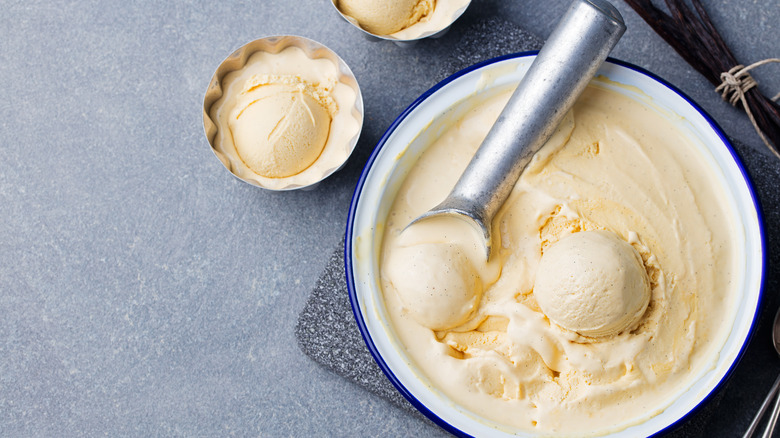Cottage Cheese Is The Unexpected Ice Cream Base You Should Try
Move over heavy cream; it's time to let the sometimes-maligned cottage cheese have its day. And no, not just as breakfast food (though that, too, is delicious). That's right: You can use full-fat cottage cheese instead of heavy cream when making ice cream for a healthy base with the same luxurious texture and versatile flavor.
Cottage cheese has long been favored as a high-protein, low-carb food to enjoy for a filling and energizing breakfast or snack. It's equal parts tangy and creamy with a delightfully clotted texture. Comparable in taste and heft to yogurt, another popular base for ice cream, cottage cheese is a logical base for ice cream with even more protein per serving. Its clotted curds blend easily into a smooth ice cream foundation to sweeten and enhance your favorite flavors and add-ins.
Cottage cheese's creamy and sour profile pairs well with a wide variety of ingredients from fruits and nuts to chocolate and vanilla. As a homemade dessert, you can make it as decadent or minimalist as you want. The result is a luxuriously rich ice cream that's high in protein, with fewer calories and saturated fat than conventional ice cream.
How to make cottage cheese ice cream
Full-fat cottage cheese is essential to achieve the desired creamy texture of conventional ice cream. You can use low-fat or nonfat cottage cheese, but you'll need to supplement it with milk to avoid an icy, watery texture.
All you need is any kind of blender, a freezer, and patience to make a pint of cottage cheese ice cream. Blenders, food processors, and immersion blenders are all worthy appliances to blend cottage cheese, your flavor of choice, and sweetener into a uniformly smooth foundation. Next, you just need to mix in any solid ingredients, like chocolate chips, pieces of fruit, or toasted nuts. Once you've blended and folded or swirled all your add-ins, transfer the ice cream into a freezer-friendly container to solidify for four hours. Some recipes recommend stirring the ice cream once every hour. You can serve the ice cream after four hours or leave it in the freezer to eat throughout the following days or weeks.
The way you sweeten and flavor cottage cheese ice cream is up to you; sugar, honey, and maple syrup are classic choices, but you can also use stevia, monk fruit extract, or erythritol if you want sugar-free ice cream. Sweeteners will help neutralize the tanginess of cottage cheese, but you can use its cheesiness to your advantage by pairing it with complementary add-ins. For example, cottage cheese and pineapple or berries are classic breakfast pairings, so you can use frozen berries or pineapple chunks in your cottage cheese ice cream.

